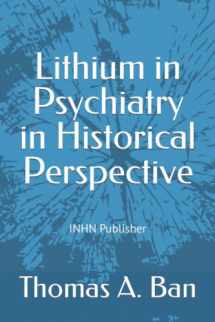
Lithium in Psychiatry in Historical Perspective
Book details
Summary
Description
Lithium in Historical Perspective is a collection of selected papers from INHN’s. To provide readily accessible information on the history of the substance, the postings are presented in eight chapters: 1. Discovery, 2. Introduction, 3. Verification, 4. Controversy, 5. Re-evaluation, 6. Safety, 7. Action and 8. Indications.
The potential use of lithium in “mania” was discovered by William T. Hammond and in “periodic depression” by Carl Lange in the19th century. There are two postings relevant to this topic: Johan Schioldann’s comment on William Hammond and Carl Lange’s speech, “On Periodical Depressions and Their Pathogenesis,” in Schioldann’s translation from Danish into English.
Instrumental to the introduction of lithium was Edward Trautner’s determination of an effective dose range in which Lithium can be safely administered. There are four contributions relevant to this topic: John Cade’s and Trautner’s biographies, by Samuel Gershon; Gershon’s autobiographic account, “Events and Memories”; and Gershon’s “Lithium History.”
The therapeutic effect of Lithium in “mania” was verified by Mogens Schou in the mid-1950s. There are three relevant to this topic: Mogens Schou’s autobiography, and Grof’s and Rybakowski’s comments on it.
Acceptance of lithium was delayed by a controversy in the mid-1960s about its prophylactic effect. There are four contributions in the collection relevant to this topic: Barry Blackwell’s essay, “The lithium controversy, a historical autopsy”; Paul Grof’s and Jules Angst’s comments on it; and Blackwell’s reply to both.
In the 1980s lithium was re-evaluated and its place in treatment consolidated. There are three papers on this topic: Grof’s comment, “More hindsight thought,” on Blackwell’s comments on Schou’s “My journey with lithium”; Blackwell’s review of Schioldann’s “History of the Introduction of Lithium into Medicine and Psychiatry: Birth of Modern Psychopharmacology 1949”; and Schioldann’s comment on Blackwell’s review.
With the prolonged use of the substance its anti-vasopressin action, causing polyuria and nephrogenic diabetes insipidus in vulnerable patients had become a safety concern. Spearheaded by the research of Radó, by the end of the second decade of the 21st-century renal toxicity of lithium could be successfully treated and prevented. There are five essays by Radó included in this collection relevant to this topic: “Mechanism of lithium-induced polyuria in historical perspective”; “Calcitonin in nephrogenic diabetes insipidus”; “Renal toxicity of lithium in historical perspective with special reference to nephrogenic diabetes insipidus”; “Desmopressin may counteract polyuria in lithium-induced nephrogenic diabetes insipidus. Review of the literature”; and “Use of modern antidiuretic agents in lithium-induced nephrogenic diabetes insipidus.”
Throughout the years the mode of action of lithium has been extensively studied. Yet, in this selection, information on its possible mode of action is restricted to its effect on the “purinergic system” presented in two essays: Magda Malewska-Kasprzak, Agnieszka Permoda-Osip, and Rybakowski’s treatise on the “Disturbances of the purinergic system in affective disorders and schizophrenia” and Rybakowski’s “Additional information: A commentary on Walter Felber’s paper on Lithium prevention of depression 100 years ago -- an ingenious misconception, published in 1987.”
The therapeutic indication of lithium extended after its introduction from the treatment of “manic excitement” to the acute, maintenance and prophylactic treatment of “manic-depressive psychosis,” referred to by that time as “bipolar disorder” in consensus-based classifications. Finally, there are two essays by Thomas Ban: “Development of the diagnostic concept of Manic-Depressive Psychosis in Emil Kraepelin’s classifications” and “From Emil Kraepelin’s Manic-Depressive Psychosis to Karl Leonhard’s Phasic and Cycloid Psychoses.”


We would LOVE it if you could help us and other readers by reviewing the book
Book review



